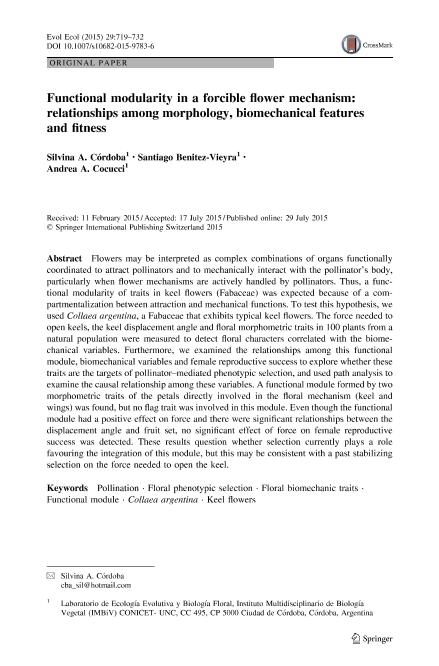Mostrar el registro sencillo del ítem
dc.contributor.author
Córdoba, Silvina Alejandra

dc.contributor.author
Benitez-Vieyra, Santiago Miguel

dc.contributor.author
Cocucci, Andrea Aristides

dc.date.available
2017-01-31T20:54:44Z
dc.date.issued
2015-09
dc.identifier.citation
Córdoba, Silvina Alejandra; Benitez-Vieyra, Santiago Miguel; Cocucci, Andrea Aristides; Functional modularity in a forcible flower mechanism: relationships among morphology, biomechanical features and fitness; Springer; Evolutionary Ecology; 29; 5; 9-2015; 719-732
dc.identifier.issn
0269-7653
dc.identifier.uri
http://hdl.handle.net/11336/12277
dc.description.abstract
Flowers may be interpreted as complex combinations of organs functionallycoordinated to attract pollinators and to mechanically interact with the pollinator?s body,particularly when flower mechanisms are actively handled by pollinators. Thus, a functional modularity of traits in keel flowers (Fabaceae) was expected because of a compartmentalization between attraction and mechanical functions. To test this hypothesis, we used Collaea argentina, a Fabaceae that exhibits typical keel flowers. The force needed to open keels, the keel displacement angle and floral morphometric traits in 100 plants from a natural population were measured to detect floral characters correlated with the biomechanical variables. Furthermore, we examined the relationships among this functional module, biomechanical variables and female reproductive success to explore whether these traits are the targets of pollinator?mediated phenotypic selection, and used path analysis to examine the causal relationship among these variables. A functional module formed by two morphometric traits of the petals directly involved in the floral mechanism (keel and wings) was found, but no flag trait was involved in this module. Even though the functional module had a positive effect on force and there were significant relationships between the displacement angle and fruit set, no significant effect of force on female reproductive success was detected. These results question whether selection currently plays a role favouring the integration of this module, but this may be consistent with a past stabilizing selection on the force needed to open the keel.
dc.format
application/pdf
dc.language.iso
eng
dc.publisher
Springer

dc.rights
info:eu-repo/semantics/openAccess
dc.rights.uri
https://creativecommons.org/licenses/by-nc-sa/2.5/ar/
dc.subject
Pollination
dc.subject
Floral Phenotypic Selection
dc.subject
Floral Biomechanic Traits
dc.subject
Functional Module
dc.subject
Collaea Argentina
dc.subject
Keel Flowers
dc.subject.classification
Biología

dc.subject.classification
Ciencias Biológicas

dc.subject.classification
CIENCIAS NATURALES Y EXACTAS

dc.subject.classification
Ecología

dc.subject.classification
Ciencias Biológicas

dc.subject.classification
CIENCIAS NATURALES Y EXACTAS

dc.title
Functional modularity in a forcible flower mechanism: relationships among morphology, biomechanical features and fitness
dc.type
info:eu-repo/semantics/article
dc.type
info:ar-repo/semantics/artículo
dc.type
info:eu-repo/semantics/publishedVersion
dc.date.updated
2017-01-31T15:37:13Z
dc.journal.volume
29
dc.journal.number
5
dc.journal.pagination
719-732
dc.journal.pais
Alemania

dc.journal.ciudad
Berlin
dc.description.fil
Fil: Córdoba, Silvina Alejandra. Consejo Nacional de Investigaciones Científicas y Técnicas. Centro Científico Tecnológico Córdoba. Instituto Multidisciplinario de Biología Vegetal (p); Argentina. Universidad Nacional de Córdoba; Argentina
dc.description.fil
Fil: Benitez-Vieyra, Santiago Miguel. Consejo Nacional de Investigaciones Científicas y Técnicas. Centro Científico Tecnológico Córdoba. Instituto Multidisciplinario de Biología Vegetal (p); Argentina. Universidad Nacional de Córdoba; Argentina
dc.description.fil
Fil: Cocucci, Andrea Aristides. Consejo Nacional de Investigaciones Científicas y Técnicas. Centro Científico Tecnológico Córdoba. Instituto Multidisciplinario de Biología Vegetal (p); Argentina. Universidad Nacional de Córdoba; Argentina
dc.journal.title
Evolutionary Ecology

dc.relation.alternativeid
info:eu-repo/semantics/altIdentifier/doi/http://dx.doi.org/10.1007/s10682-015-9783-6
dc.relation.alternativeid
info:eu-repo/semantics/altIdentifier/url/http://link.springer.com/article/10.1007%2Fs10682-015-9783-6
Archivos asociados
